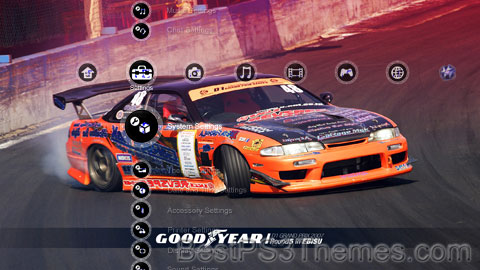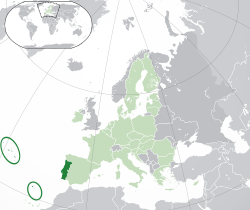Denver Nuggets theme by nbafanscw
Download: DenverNuggets.p3t
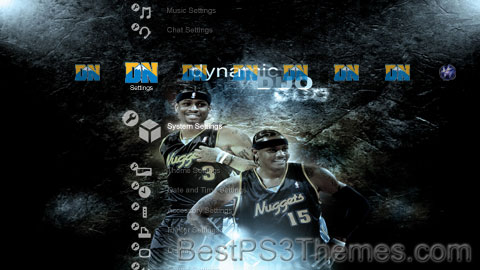
(1 background)
| Denver Nuggets | ||||
|---|---|---|---|---|
 | ||||
| Conference | Western | |||
| Division | Northwest | |||
| Founded | 1967 | |||
| History | Denver Rockets 1967–1974 (ABA) Denver Nuggets 1974–1976 (ABA) 1976–present (NBA)[1][2][3] | |||
| Arena | Ball Arena[4] | |||
| Location | Denver, Colorado | |||
| Team colors | Midnight blue, sunshine yellow, Flatirons red, skyline blue[5][6][7] | |||
| Main sponsor | Ibotta[8] | |||
| CEO | Josh Kroenke | |||
| President | Josh Kroenke[9] | |||
| General manager | Calvin Booth[10] | |||
| Head coach | Michael Malone | |||
| Ownership | Kroenke Sports & Entertainment (Stan Kroenke, Owner/Governor)[11][12] | |||
| Affiliation(s) | Grand Rapids Gold[13][14] | |||
| Championships | 1 (2023) | |||
| Conference titles | 1 (2023) | |||
| Division titles | 12 ABA: 2 (1970, 1975) NBA: 10 (1977, 1978, 1985, 1988, 2006, 2009, 2010, 2019, 2020, 2023) | |||
| Retired numbers | 6 (2, 12, 33, 40, 44, 55, 432) | |||
| Website | www | |||
| ||||
The Denver Nuggets are an American professional basketball team based in Denver. The Nuggets compete in the National Basketball Association (NBA) as a member of the Northwest Division of the Western Conference. The team was founded as the Denver Larks in 1967 as a charter franchise of the American Basketball Association (ABA) but changed their name to the Rockets before the first season.[15] The Rockets then changed their name again to the Nuggets in 1974.[16] After the name change, the Nuggets played for the final ABA Championship title in 1976, losing to the New York Nets.
The team has had some periods of success, qualifying for the ABA playoffs in every season of the ABA's existence (except 1971 and 1974), losing in the 1976 ABA Finals to the New York Nets.[17] The team joined the NBA in 1976 after the ABA–NBA merger and qualified for the NBA playoffs in nine consecutive seasons in the 1980s and ten consecutive seasons from 2004 to 2013.[17] In 2023, the Nuggets, led by Nikola Jokić and Jamal Murray, reached their first NBA Finals and defeated the Miami Heat to capture the franchise's first NBA championship. The Nuggets were the last of the four surviving former ABA teams to reach the NBA Finals, and the second former ABA team to win an NBA title (after the San Antonio Spurs).[17][18] The Nuggets play their home games at Ball Arena,[4] which they share with the Colorado Avalanche of the National Hockey League (NHL) and the Colorado Mammoth of the National Lacrosse League (NLL).
Franchise history[edit]
1967–1969: Franchise background and founding[edit]
Prior to the 1948–49 National Basketball League (NBL) season, the original Denver Nuggets were founded. Following that season, the NBL merged with the Basketball Association of America (BAA), with the newly unified circuit named the National Basketball Association to reflect the merger. The Denver Nuggets played the 1949–50 season as one of the charter NBA teams before folding. This franchise's records and statistics remain separate from the modern-day Denver Nuggets.

The current franchise traces its roots to 1967, when one of the American Basketball Association (ABA)'s charter franchises was awarded to a group in Kansas City, Missouri, headed by Southern California businessman James Trindle. However, Trindle was unable to find a suitable arena in the Kansas City area. League commissioner George Mikan suggested moving the team to Denver. After agreeing to name Denver resident and former NBA player Vince Boryla as general manager, Trindle moved his team to Denver as the Denver Larks, named after Colorado's state bird.[19] The Trindle group was severely undercapitalized, leading Mikan to order the Larks to post a $100,000 performance bond or lose the franchise. Hours before the deadline, Trindle sold a ⅔ controlling interest to Denver trucking magnate Bill Ringsby for $350,000. Ringsby then renamed the team the Rockets, after his company's long-haul trucks.[20]
1969–1976: ABA years[edit]
Playing at the Denver Auditorium Arena, the Rockets had early successes on the court, developing a strong fan base along the way.[21] However, the team had a history of early playoff exits and only once played in the ABA championship series.
Early, Denver had a solid lineup led by Byron Beck and Larry Jones, then later by Beck and Ralph Simpson. Lonnie Wright of the American Football League's Denver Broncos signed with the Rockets during that first season and became the first player to play professional football and basketball in the same season. Wright played four seasons with Denver.[21] Controversial rookie Spencer Haywood joined the team for the 1969–70 season. Haywood was one of the first players to turn pro before graduating from college, and the NBA initially refused to let him play in the league. Haywood averaged nearly 30 points and 19.5 rebounds per game in his only ABA season, being named ABA MVP, ABA rookie of the year, as well as the All-Star Game MVP. The team finished 51–33, winning their division, before exiting the playoffs in the 2nd round.
Just before the start of the 1970–71 season, Haywood signed with the Seattle SuperSonics, jumping to the NBA. The team tumbled to a 30–54 record and attendance suffered.[21]
Becoming the Denver Nuggets[edit]
Ringsby sold the team to San Diego businessmen Frank Goldberg and Bud Fischer in 1972.[19] In 1974, in anticipation of moving into the NBA, and the new McNichols Arena, the franchise held a contest to choose a new team nickname, as "Rockets" was already in use by the Houston Rockets. The winning choice was "Nuggets", in honor of the original Denver Nuggets team from 1948 to 1950, the last year as a charter member of the NBA. Their new logo was a miner "discovering" an ABA ball. Goldberg and Fischer in turn sold the team to a local investment group in 1976.
With the drafting and signing of future Hall of Fame player David Thompson out of North Carolina State and Marvin Webster, and the acquisitions of Dan Issel and Bobby Jones (all signed for the 1975–76 season), with Larry Brown coaching, they had their best seasons in team history in their first two as the Nuggets. Playing in the Denver Auditorium Arena for the last season the 1974–75 team went 65–19, including a 40–2 record at home. However, they lost in the Western Conference Finals in 7 games, to the Indiana Pacers.[22]
In 1975–76, playing at their new arena, the Nuggets, with the acquisitions of Thompson, Jones and Dan Issel who had come via a trade after he won an ABA title with the 1974–75 Kentucky Colonels, the team went 60–24, edged the reigning champion Kentucky Colonels four games to three to make the 1976 ABA finals for the first time. Eventually, they lost to the New York Nets and Julius Erving in 6 games.[22] They did not get a second chance to win an ABA league championship, as the ABA–NBA merger took place after the 1975–76 season. The Nuggets, Nets, Indiana Pacers, and San Antonio Spurs were merged into the NBA. The Spirits of St. Louis and Kentucky Colonels were disbanded.[23]
1976–1982: Early NBA years[edit]
The Nuggets and Nets had actually applied to join the NBA in 1975, but were forced to stay in the ABA by a court order. The Nuggets continued their strong play early on in the NBA, as they won division titles in their first two seasons in the league, and missed a third by a single game. However, neither of these teams were ultimately successful in the postseason. Similarly to the other new NBA teams, the Nuggets were saddled with stiff financial obligations upon joining the NBA, including a $2 million entry fee. Red McCombs bought the team in 1978.
In 1979, Brown left the team, helping usher in a brief decline in their performance. It ended in 1981, when they hired Doug Moe as a head coach. Moe brought with him a "motion offense" philosophy, a style of play focusing on attempting to move the ball until someone got open. Moe was also known for not paying as much attention to defense as other NBA coaches. The offense helped the team become highly competitive. During the 1980s, the Nuggets often[quantify] scored in excess of 115 points a game, and during the 1981–82 season, they scored at least 100 points in every game. The NBA-record streak was halted at 136 consecutive games.[24] During the 1981–82 season, the Nuggets set the league scoring record for the highest points per game average at 126.5 points.
1982–1989: The Alex English era[edit]
Anchored by scoring machines Alex English and Kiki Vandeweghe at the two forward spots, and Dan Issel at center, Denver led the league in scoring, with English and Vandeweghe both averaging above 25 points per game. It was a novel strategy, allowing the Nuggets to top the Midwest Division and qualify for the playoffs during that span. (On December 13, 1983, the Nuggets and the visiting Detroit Pistons combined for an NBA record 370 points, with Detroit winning in triple overtime, 186–184.) At the end of the season, English won the NBA scoring title, becoming the only Nugget to win the award despite the heavily favored offensive play of Doug Moe. In 1984–85, they made it to the Western Conference finals after being perennial playoff contenders, and they lost in five games to the Los Angeles Lakers.
Vandeweghe was traded before the 1984–85 season to the Portland Trail Blazers for 6–3 rebounding guard Fat Lever, undersized power forward Calvin Natt and center Wayne Cooper. Spearheaded by Alex English and supported by the three new acquisitions and defensive specialists Bill Hanzlik and TR Dunn, the team replicated its success in the Western Conference despite the loss of Vandeweghe. They even managed to win 54 games in the 1987–88 season, the most they had ever won as an NBA team. However, the Mavericks eliminated the Nuggets in the second round of the 1988 NBA Playoffs. McCombs sold the team to Sidney Shlenker in 1985. Shlenker, in turn, sold the team to COMSAT in 1989.
1989–1991: A period of decline[edit]
Moe left the team in 1990, and was replaced by Paul Westhead. Westhead also believed in a "run and gun" style of play allowing players to speed down the court to shoot rather than creating set plays.[25]
1991–1996: The Dikembe Mutombo era[edit]

Denver took a positive step in rebuilding by drafting Georgetown University center Dikembe Mutombo in 1991. Mutombo finished runner-up to Larry Johnson for the NBA rookie of the year that season. Denver finished 24–58 that year.
Denver fired Westhead prior to the 1992–93 season and hired former star player Dan Issel as his successor. The Nuggets had two lottery picks that year and drafted University of Notre Dame forward LaPhonso Ellis and University of Virginia guard Bryant Stith. Denver improved to 36–46, just missing the playoffs that year.
Denver ditched their rainbow colors for a dark navy, metallic gold and wine color scheme starting in the 1993–94 season. Led by Mutombo, Mahmoud Abdul-Rauf (who changed his name from Chris Jackson prior to the season), and Ellis, Denver finished with its first winning season since the Doug Moe era at 42–40. Denver clinched the eighth seed in the Western Conference playoffs, playing the first place Seattle SuperSonics. Denver was a heavy underdog, having only a couple of players on their roster with actual NBA playoff experience. After dropping the first two games of the five-game set in Seattle, the series returned to Denver. Denver won both games and tied the series at 2. The Nuggets made NBA history in Game 5, upsetting Seattle in overtime 98–94. They became the first 8th-seeded team to defeat a 1st-seeded team in NBA playoff history. Denver almost repeated the feat before falling to the Utah Jazz in Game 7 of the second round.
Denver acquired Sonics sharp-shooter Dale Ellis in the off-season and drafted University of Michigan guard Jalen Rose. Denver struggled, causing Issel to resign as coach partway into the season. Assistant Coach Gene Littles assumed control for a brief period before relinquishing control to general manager Bernie Bickerstaff. Denver rebounded and earned the eighth seed again in the playoffs, finishing 41–41. The Nuggets were swept by the San Antonio Spurs in the first round of the playoffs that season.
Following that season, Denver acquired Antonio McDyess in a draft-day trade with the Los Angeles Clippers. McDyess was the face of the franchise for the next few years, as Mutombo left after the 1995–96 season for the Atlanta Hawks, Ellis missed the majority of the next few seasons due to recurring knee and leg injuries, Rose was traded to the Indiana Pacers for Mark Jackson, and Abdul-Rauf was traded to the Sacramento Kings prior to the 1996–97 season.
1996–2003: Another period of struggle[edit]
After finishing the 1996–97 season with the fourth-worst record in the league (21–61), the Nuggets sent Antonio McDyess to the Phoenix Suns, and Dale Ellis returned to Seattle. Denver flirted with history in the 1997–98, by nearly setting the mark for fewest wins in an 82-game season (11). They tied the then-NBA's all-time worst single-season losing streak at 23—only one game shy of the overall worst mark of 24 by the Cleveland Cavaliers of the early 1980s. The losing streak was later broken by the Cavaliers in 2011 and the Philadelphia 76ers in 2014 with 26 consecutive losses. Several years later, the Nuggets tied for the worst record in the NBA in 2002–03, also with the Cavaliers.
New ownerships[edit]
The team's struggles in the late 1990s were due in part to ownership instability. COMSAT bought the NHL's Quebec Nordiques in 1995 and moved them to Denver as the Colorado Avalanche. However, its diversification into sports ownership was proving a drain on the company. In particular, cost overruns associated with the construction of Pepsi Center had shareholders up in arms. Finally, in 1997, COMSAT agreed in principle to sell Ascent Entertainment Group, the umbrella corporation for its sporting assets, to Liberty Media.[19] However, Liberty was not interested in sports ownership at the time (though it has since bought the Atlanta Braves), and made the deal contingent upon Ascent selling the Avalanche and Nuggets.[26]
After almost two years, Ascent sold the Avalanche and Nuggets to Walmart heirs Bill and Nancy Laurie for $400 million. However, a group of Ascent shareholders sued, claiming that the sale price was several million dollars too low. Ascent then agreed to sell the Avalanche and Nuggets to Denver banking tycoon Donald Sturm for $461 million.[27]
However, a new wrinkle appeared when the city of Denver refused to transfer the parcel of land on which Pepsi Center stood unless Sturm promised to keep the Avalanche and Nuggets in Denver for at least 25 years. Sturm had bought the teams in his own name, and the city wanted to protect taxpayers in the event Sturm either died or sold the teams. While Sturm was willing to make a long-term commitment to the city, he was not willing to be held responsible if he died or sold the teams. After negotiations fell apart, Liberty bought all of Ascent, but kept the Nuggets and Avalanche on the market.[28] In the meantime, Issel had returned as head coach in 1999, but the protracted ownership negotiations made it difficult for him to rebuild the team. Just before the start of the 1999–2000 season, he told reporters there were several personnel moves he simply could not make due to the unstable ownership situation. Under the terms of Strum's purchase agreement, all basketball decisions required the approval of both Ascent/Liberty and Sturm.[29]
Finally, in July 2000, the Avalanche, Nuggets and Pepsi Center were bought by real estate entrepreneur Stan Kroenke in a $450 million deal.[19] Kroenke is the brother-in-law of the Lauries; his wife Ann is Nancy Laurie's sister. Liberty retained a 6.5% interest. As part of the deal, Kroenke placed the teams into a trust that would ensure the teams will stay in Denver until at least 2025.[28] After the deal, Kroenke organized his sports assets under Kroenke Sports Enterprises.
2003–2011: The Carmelo Anthony era[edit]

In 2003, the Nuggets drafted future All-Star Carmelo Anthony with the third overall pick in the 2003 NBA draft.[30] That same year, the team also updated their logos and uniforms, with a new color scheme of powder blue, gold and royal blue; the latter color was changed to navy blue in 2008.[31] In just two months of the season, the Nuggets recorded more wins than they had in 5½ months of play in 2002–03. Much of the reason for this incredible turnaround were the front-office moves of general manager Kiki Vandeweghe, a former Nuggets player who assumed general manager duties on August 9, 2001.[32] In April, the turnaround was complete as they became the first franchise in NBA history to qualify for the postseason following a sub-20-win campaign the previous year since the NBA went to an 82-game schedule.[32] They were eliminated in the first round four games to one by the Minnesota Timberwolves.[33]
On December 28, 2004, head coach Jeff Bzdelik was fired from the organization and replaced by interim coach, former Los Angeles Lakers player and Los Angeles Sparks head coach Michael Cooper.[34] The Nuggets later hired George Karl as a permanent replacement.[35] Karl led the team to a record of 32–8 in the second half of the regular season, which vaulted the team into the playoffs for the second consecutive year.[36]
In the playoffs, however, the Nuggets could not survive the San Antonio Spurs. After winning game one in San Antonio, the Nuggets proceeded to lose the next four games and lost the series 4–1.[37] The Nuggets picked 20th in the 2005 NBA draft; it was acquired from the Washington Wizards via the Orlando Magic.[38] Denver selected Julius Hodge with the pick. The Nuggets also had the 22nd overall selection in the draft, in which they selected Jarrett Jack, but sent him to the Portland Trail Blazers for rights to Portland's 27th overall pick, Linas Kleiza.[38]
In 2005–06, for the first time in 18 years, the club won the Northwest division title.[39] This placed the team in the third seed of the Western Conference playoffs. Denver played the Los Angeles Clippers who, despite their sixth seeding, had a better regular season record. As a result, the Clippers received home-court advantage. They defeated the Nuggets in 5 games. Shortly after, the Nuggets announced that general manager Kiki Vandeweghe's contract would not be renewed. He was replaced by Mark Warkentien.[40]
Woodward
Woodward theme by PSN Design
Download: Woodward.p3t
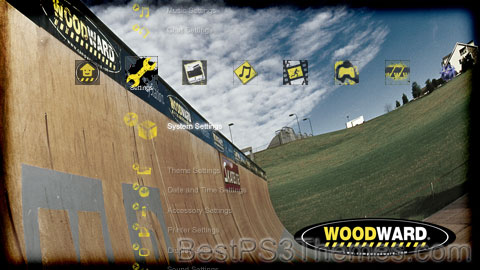
(2 backgrounds)
A woodward is a warden of a wood. Woodward may also refer to:
Places[edit]
- United States
- Woodward, Iowa
- Woodward, Oklahoma
- Woodward, Pennsylvania, a census-designated place
- Woodward Avenue, a street in Tallahassee, Florida, which bisects the campus of Florida State University
- Woodward Avenue, a Michigan state highway
- Woodward Corridor, a neighborhood in Detroit, Michigan
- Woodward County, Oklahoma
- Woodward Park (disambiguation), multiple places
- Woodward Pond, a man-made pond in Bowie, Maryland
- Woodward Township, Pennsylvania (disambiguation), multiple places
People[edit]
Businesses[edit]
- Woodward, Inc., American maker of energy devices
- Woodward & Lothrop, American department store chain
- Woodward Iron Company, in Birmingham (Woodward) Alabama
- Woodward's, Canadian department store chain
- The Woodward's building in Vancouver, British Columbia
Education[edit]
- Woodward Academy, a private school in Georgia (United States)
- Woodward High School (Cincinnati, Ohio), one of the oldest public high schools still in operation in the United States
- Woodward School for Girls, a private school in Quincy, Massachusetts (United States)
Other uses[edit]
- 1947 Glazier–Higgins–Woodward tornado outbreak
- Dartmouth College v. Woodward, an 1819 U.S. Supreme Court case
- Woodward Camp, a youth summer camp in Pennsylvania
- Woodward Dream Cruise, a classic car event held in Michigan
- Woodward–Hoffmann rules, possible predictors of the stereochemistry of pericyclic reactions
See also[edit]
- Woodard (disambiguation) (note different spelling)
- Justice Woodward (disambiguation)
- Woodyard (disambiguation)
Sooner Football
Sooner Football theme by T Murder
Download: SoonerFootball.p3t
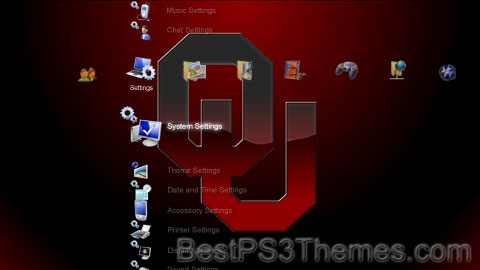
(5 backgrounds)
P3T Unpacker v0.12
Copyright (c) 2007. Anoop Menon
This program unpacks Playstation 3 Theme files (.p3t) so that you can touch-up an existing theme to your likings or use a certain wallpaper from it (as many themes have multiple). But remember, if you use content from another theme and release it, be sure to give credit!
Download for Windows: p3textractor.zip
Instructions:
Download p3textractor.zip from above. Extract the files to a folder with a program such as WinZip or WinRAR. Now there are multiple ways to extract the theme.
The first way is to simply open the p3t file with p3textractor.exe. If you don’t know how to do this, right click the p3t file and select Open With. Alternatively, open the p3t file and it will ask you to select a program to open with. Click Browse and find p3textractor.exe from where you previously extracted it to. It will open CMD and extract the theme to extracted.[filename]. After that, all you need to do for any future p3t files is open them and it will extract.
The second way is very simple. Just drag the p3t file to p3textractor.exe. It will open CMD and extract the theme to extracted.[filename].
For the third way, first put the p3t file you want to extract into the same folder as p3textractor.exe. Open CMD and browse to the folder with p3extractor.exe. Enter the following:
p3textractor filename.p3t [destination path]Replace filename with the name of the p3t file, and replace [destination path] with the name of the folder you want the files to be extracted to. A destination path is not required. By default it will extract to extracted.filename.
FC Barcelona #2
FC Barcelona theme by Abel C Prince
Download: FCBarcelona_2.p3t
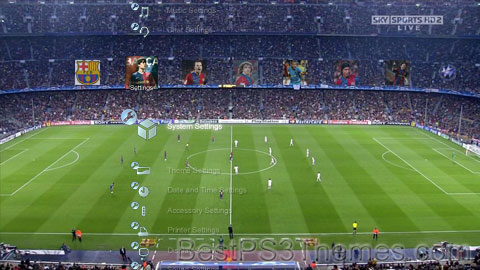
(1 background)
 | ||||
| Full name | Futbol Club Barcelona | |||
|---|---|---|---|---|
| Nickname(s) | Barça or Blaugrana (team) Culers or Barcelonistes (supporters) Blaugranes or Azulgranas (supporters) | |||
| Founded | 29 November 1899 as Foot-Ball Club Barcelona | |||
| Stadium | Estadi Olímpic Lluís Companys | |||
| Capacity | 54,367[1] | |||
| President | Joan Laporta | |||
| Head coach | Hansi Flick | |||
| League | La Liga | |||
| 2023–24 | La Liga, 2nd of 20 | |||
| Website | Club website | |||
|
| ||||
| Closed departments of FC Barcelona | ||||||
|---|---|---|---|---|---|---|
|
Futbol Club Barcelona (Catalan pronunciation: [fubˈbɔl ˈklub bəɾsəˈlonə] ), commonly known as Barcelona and familiarly as Barça ([ˈbaɾsə]), is a professional football club based in Barcelona, Catalonia, Spain, that competes in La Liga, the top flight of Spanish football.
Founded in 1899 by a group of Swiss, Catalan, German, and English footballers led by Joan Gamper, the club has become a symbol of Catalan culture and Catalanism, hence the motto "Més que un club" ("More than a club").[2] Unlike many other football clubs, the supporters own and operate Barcelona. It is the third-most valuable football club in the world, worth $5.51 billion, and the world's fourth richest football club in terms of revenue, with an annual turnover of €800.1 million.[3][4] The official Barcelona anthem is the "Cant del Barça", written by Jaume Picas and Josep Maria Espinàs.[5] Barcelona traditionally play in dark shades of blue and garnet stripes, hence nicknamed Blaugrana.
Domestically, Barcelona has won a record 77 trophies: 27 La Liga, 31 Copa del Rey, 14 Supercopa de España, three Copa Eva Duarte, and two Copa de la Liga titles, as well as being the record holder for the latter four competitions. In international club football, the club has won 22 European and worldwide titles: five UEFA Champions League titles, a record four UEFA Cup Winners' Cups, a joint record five UEFA Super Cups, a record three Inter-Cities Fairs Cups, a joint record two Latin Cups, and three FIFA Club World Cups.[6][7][8] Barcelona was ranked first in the International Federation of Football History & Statistics Club World Ranking for 1997, 2009, 2011, 2012, and 2015, and occupies the ninth position on the UEFA club rankings as of May 2023[update].[9][10][11] The club has a long-standing rivalry with Real Madrid, and matches between the two teams are referred to as El Clásico.
Barcelona is one of the most widely supported teams in the world, and the club has one of the largest social media following in the world among sports teams.[12][13] Barcelona players have won a joint record twelve Ballon d'Or awards, with recipients including Johan Cruyff, as well as a record six FIFA World Player of the Year awards, with winners including Romário, Ronaldo, Rivaldo, Ronaldinho and Lionel Messi. In 2010, three players who came through the club's youth academy—Lionel Messi, Andrés Iniesta and Xavi—were chosen as the three best players in the world in the Ballon d'Or ranking, an unprecedented feat for players from the same football academy.[14][15] Additionally, players representing the club have won a record eight European Golden Shoe awards.[16]
Barcelona is one of three founding members of the Primera División that have never been relegated from the top division since its inception in 1929, along with Athletic Bilbao and Real Madrid.[17][18] In 2009, Barcelona became the first Spanish club to win the continental treble consisting of La Liga, Copa del Rey and the UEFA Champions League, and also became the first European football club to win six out of six competitions in a single year, by also winning the Spanish Super Cup, UEFA Super Cup and FIFA Club World Cup.[19] In 2011, the club became European champions again, winning five trophies.[20] This Barcelona team, which won fourteen trophies in just four years under Pep Guardiola, is considered by some in the sport to be the greatest team of all time.[21][22][23] By winning their fifth Champions League trophy in 2015 under Luis Enrique, Barcelona became the first European football club in history to achieve the continental treble twice.[24]
History[edit]
1899–1922: Beginnings[edit]

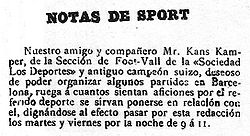
Stade Toulousain
Stade Toulousain theme by Louxx
Download: StadeToulousain.p3t
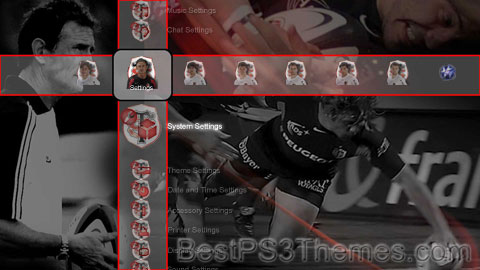
(3 backgrounds)
You can help expand this article with text translated from the corresponding article in French. (August 2012) Click [show] for important translation instructions.
|
 | ||||
| Full name | Stade Toulousain | |||
|---|---|---|---|---|
| Nickname(s) | Le Stade Les Rouge et Noir (The Red and Blacks) | |||
| Founded | 1907 | |||
| Location | Toulouse, France | |||
| Ground(s) | Stade Ernest-Wallon (Capacity: 19,500) | |||
| President | Didier Lacroix | |||
| Coach(es) | Ugo Mola | |||
| Captain(s) | Julien Marchand | |||
| Most appearances | Jean Bouilhou (392) | |||
| Top scorer | Thomas Ramos (1,792) | |||
| Most tries | Vincent Clerc (134) | |||
| League(s) | Top 14 | |||
| 2023–24 | 1st | |||
| ||||
| Official website | ||||
| www | ||||
Stade Toulousain (French pronunciation: [stad tuluzɛ̃]) (Occitan: Estadi Tolosenc), also referred to as Toulouse, is a professional rugby union club based in Toulouse, France. They compete in the Top 14, France's top division of rugby, and the European Rugby Champions Cup.
Toulouse is the most successful club in Europe, having won the Heineken Cup/European Rugby Champions Cup a record six times – in 1996, 2003, 2005, 2010, 2021 and 2024. They were also runners-up in 2004 and 2008 against London Wasps and Munster, respectively. Stade Toulousain have also won a record 23 Boucliers de Brennus, the French domestic league trophy. It is traditionally one of the main providers for the French national team and its youth academy is one of the best in the world. Stade Toulousain also have the biggest fan base in Europe, and the biggest social media and brand presence of any non-national rugby team across both league and union.
Their home ground is the Stade Ernest-Wallon. However, big Top 14 matches along with European games are often played at the Stadium Municipal de Toulouse. The club colours are red, black and white.
History[edit]
Roots and foundation[edit]
Before 1907, rugby union in Toulouse was only played in schools or universities. In 1893, students of secondary school "Lycée de Toulouse" got together in a new team "Les Sans-Soucis". Once attending university, the same students founded "l'Olympique Toulousain", which became "Stade Olympien des Étudiants de Toulouse" (SOET) a few years later in 1896. In the same period, 'non-students' grouped in "le Sport Athlétique Toulousain" (SAT) while students of the veterinary school created "l'Union Sportive de l'École Vétérinaire" (USEV). Both entities merged in 1905 and called themselves "Véto-Sport". Finally in 1907, Stade Toulousain was founded resulting from a union between the SOET and Véto-Sport.
Since its creation in 1907, Stade Toulousain drew on the past of the city. The design of Stade Toulousain's crest refers to the initials of Thomas Aquinas (transl. Saint Thomas in French ; S and T, same as the club's name) whose bones rest in the Church of the Jacobins, in Toulouse. The interlaced letters came from a famous tiled floor of the Basilica of Saint-Sernin, where the relics were temporarily moved for almost two centuries after the French Revolution.[1] The historical colours, red and black, are rooted in the ceremonial costume of the capitouls of Toulouse. A municipal body created in 1147, the capitouls were until the French Revolution the consuls of the city. Their traditional costume was red and black (with white bands), as shown in the oldest portraits dating from the 14th century.[2]
Early years[edit]

Stade Toulousain played its first final of the national title French Championship in 1909 and lost it to Stade Bordelais Université Club (17–0) in Toulouse. In 1912 Stade Toulousain won its first national title. It had to wait until 1922 before it won its second. However the 1920s were a golden era for the club. Their first final action in the 1920s was in 1921, when they were defeated by USA Perpignan. Despite losing in 1921, the side went on to win the 1922, 1923, 1924, 1926 and 1927 championships.
1930s to 1950s[edit]
The following decades were relatively quiet after such a dominant era during the 1920s. Stade Toulousain would not make it to any grand finals during the 1930s, and it would not be until the late 1940s when they would return. However they did contest the Challenge Yves du Manoir with RC Toulon in 1934, though it ended in a nil-all tie and both teams were winners. The club made it to the final of the 1947 championship, and claimed the premiership, beating SU Agen, 10 to 3. However, no such championships followed, the club was again relatively quiet on the championship. It was 22 years in the waiting; Toulouse made it to the final, but were defeated by the CA Bègles club.
1970s to 1980s[edit]
In 1971 Toulouse contested the Challenge Yves du Manoir against US Dax, losing 18 to 8. Eleven years after the CA Bègles defeat, the club was again disappointed in the final, being defeated by AS Béziers in the championship game of 1980. The latter end of the decade was however, reminiscent of the 1920s sides. Toulouse were again contesting the Challenge Yves du Manoir for the 1984 season, though they lost to RC Narbonne 17 to 3. They did however claim their first championship since 1947, defeating RC Toulon in the 1985 final. The following season saw them successfully defend their championship, defeating SU Agen in the final. After a number of defeats in the Challenge Yves du Manoir finals, Toulouse defeated US Dax to win the 1988 competition. Both Toulon and Agen won the following premierships (1987 and 1988) but Toulouse won another championship in 1989.
1990s to present[edit]
The dominance continued in the 1990s, starting with a grand final loss in 1991, and a Challenge Yves du Manoir championship in 1993, defeating Castres 13 to 8 in the final. The mid-1990s saw Stade Toulousain become a major force yet again, as the club claimed four premierships in a row, winning the championship in 1994, 1995, 1996 and 1997, as well as the Challenge Yves du Manoir in 1995. The club emulated its success in the European Rugby Cup, becoming the first ever champions in the 1995–96 season.

The late 1990s and the 2000s saw the club again reach great heights. The club won the Challenge Yves du Manoir in 1998, defeating Stade Français Paris, the 1999 championship as well as the 2001 championship. They also were runners-up in the 2003 season, losing to Stade Français in the final. As the club had done in the mid-1990s, Stade Toulousain replicated this success in the European Rugby Cup, winning the 2002–03 and the 2004–05 cups. The club made it to the final of the 2005-06 Top 14, and despite only trailing Biarritz 9–6 at half time, Toulouse could not prevent a second-half whitewash, eventually going down 40–13. They ended their seven-year title drought with a 26–20 win over ASM Clermont Auvergne on 28 June 2008. In 2008 they narrowly lost a Heineken Cup Final to Munster by 3 points. In 2010 Toulouse defeated Leinster to reach the final where they faced Biarritz Olympique at Stade de France in Paris on Saturday 22 May 2010. Toulouse won the game by 21–19 to claim their fourth Heineken Cup title,[3][4] making them the first club to win the title four times. Stade Toulousain is also the only French club to have taken part in all the editions of Heineken Cup since its creation (17, with the 2011–12 season). They won the French championship in 2011 against Montpellier (15–10) and 2012 against Toulon (18–12). Stade Toulousain reached the semi-finals of the French championship 20 consecutive years (from 1994 to 2013). In 2019, Toulouse came back to victory, earning a 20th French Rugby Union Championship title before making an historic double, winning the 2021 Champions Cup and the 2021 Top 14. Their latest title is the 2023 French championship earned against La Rochelle, teams were ranked respectively first and second of the regular season 2023. They won the champions cup for the 6th time after beating Leinster 31-22 at the Tottenham Hotspur stadium and as a result became the highest ranked team in Europe
Stadium[edit]


Toulouse play their home games at the Stade Ernest-Wallon, which was built in the late 1980s and was recently renovated. It has a capacity of 19,500. Stade Toulousain is one of the rare teams, in France and especially in rugby union, that own its stadium. Since February 2020, it has also been home to rugby league team Toulouse Olympique, which currently competes in the 2nd tier Championship, following negotiations and an agreement between both executive boards.[5]
The stadium however cannot always accommodate all the fans of the Toulouse club. For the larger fixtures, such as championship or Champions Cup games or play-offs, the fixture may be moved to Stadium de Toulouse, which has more capacity, 33,150. The stadium was used for numerous matches at the 2007 Rugby World Cup and will host the 2023 Rugby World Cup.[6]
Honours[edit]

- Heineken Cup/European Rugby Champions Cup
- French championship Top 14
- Challenge Yves du Manoir
- Champions (4): 1934, 1988, 1993, 1995
- Runners-up (2): 1971, 1984
MotoX Colors
MotoX Colors theme by EffECKTz
Download: MotoXColors.p3t
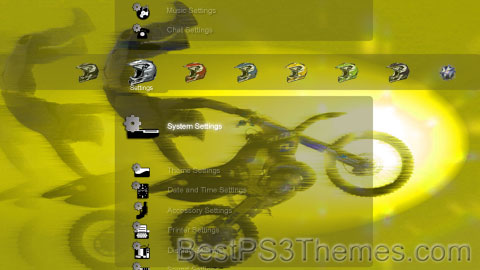
(5 backgrounds)
P3T Unpacker v0.12
Copyright (c) 2007. Anoop Menon
This program unpacks Playstation 3 Theme files (.p3t) so that you can touch-up an existing theme to your likings or use a certain wallpaper from it (as many themes have multiple). But remember, if you use content from another theme and release it, be sure to give credit!
Download for Windows: p3textractor.zip
Instructions:
Download p3textractor.zip from above. Extract the files to a folder with a program such as WinZip or WinRAR. Now there are multiple ways to extract the theme.
The first way is to simply open the p3t file with p3textractor.exe. If you don’t know how to do this, right click the p3t file and select Open With. Alternatively, open the p3t file and it will ask you to select a program to open with. Click Browse and find p3textractor.exe from where you previously extracted it to. It will open CMD and extract the theme to extracted.[filename]. After that, all you need to do for any future p3t files is open them and it will extract.
The second way is very simple. Just drag the p3t file to p3textractor.exe. It will open CMD and extract the theme to extracted.[filename].
For the third way, first put the p3t file you want to extract into the same folder as p3textractor.exe. Open CMD and browse to the folder with p3extractor.exe. Enter the following:
p3textractor filename.p3t [destination path]Replace filename with the name of the p3t file, and replace [destination path] with the name of the folder you want the files to be extracted to. A destination path is not required. By default it will extract to extracted.filename.
Banner 17
Banner 17 theme by Boston85
Download: Banner17.p3t
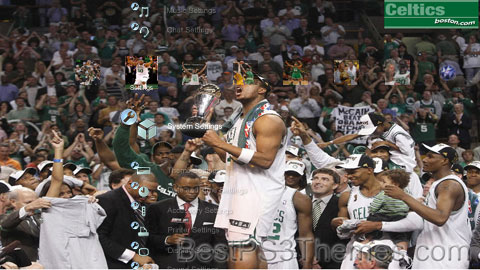
(6 backgrounds)
P3T Unpacker v0.12
Copyright (c) 2007. Anoop Menon
This program unpacks Playstation 3 Theme files (.p3t) so that you can touch-up an existing theme to your likings or use a certain wallpaper from it (as many themes have multiple). But remember, if you use content from another theme and release it, be sure to give credit!
Download for Windows: p3textractor.zip
Instructions:
Download p3textractor.zip from above. Extract the files to a folder with a program such as WinZip or WinRAR. Now there are multiple ways to extract the theme.
The first way is to simply open the p3t file with p3textractor.exe. If you don’t know how to do this, right click the p3t file and select Open With. Alternatively, open the p3t file and it will ask you to select a program to open with. Click Browse and find p3textractor.exe from where you previously extracted it to. It will open CMD and extract the theme to extracted.[filename]. After that, all you need to do for any future p3t files is open them and it will extract.
The second way is very simple. Just drag the p3t file to p3textractor.exe. It will open CMD and extract the theme to extracted.[filename].
For the third way, first put the p3t file you want to extract into the same folder as p3textractor.exe. Open CMD and browse to the folder with p3extractor.exe. Enter the following:
p3textractor filename.p3t [destination path]Replace filename with the name of the p3t file, and replace [destination path] with the name of the folder you want the files to be extracted to. A destination path is not required. By default it will extract to extracted.filename.
Celtics Champs
Celtics Champs theme by DKGBOSTON
Download: CelticsChamps.p3t
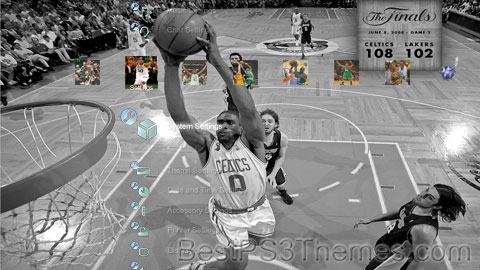
(7 backgrounds)
P3T Unpacker v0.12
Copyright (c) 2007. Anoop Menon
This program unpacks Playstation 3 Theme files (.p3t) so that you can touch-up an existing theme to your likings or use a certain wallpaper from it (as many themes have multiple). But remember, if you use content from another theme and release it, be sure to give credit!
Download for Windows: p3textractor.zip
Instructions:
Download p3textractor.zip from above. Extract the files to a folder with a program such as WinZip or WinRAR. Now there are multiple ways to extract the theme.
The first way is to simply open the p3t file with p3textractor.exe. If you don’t know how to do this, right click the p3t file and select Open With. Alternatively, open the p3t file and it will ask you to select a program to open with. Click Browse and find p3textractor.exe from where you previously extracted it to. It will open CMD and extract the theme to extracted.[filename]. After that, all you need to do for any future p3t files is open them and it will extract.
The second way is very simple. Just drag the p3t file to p3textractor.exe. It will open CMD and extract the theme to extracted.[filename].
For the third way, first put the p3t file you want to extract into the same folder as p3textractor.exe. Open CMD and browse to the folder with p3extractor.exe. Enter the following:
p3textractor filename.p3t [destination path]Replace filename with the name of the p3t file, and replace [destination path] with the name of the folder you want the files to be extracted to. A destination path is not required. By default it will extract to extracted.filename.
Good Year #2
Portugal #2
Portugal theme by Xickam (93)
Download: Portugal_2.p3t

(1 background)
Portuguese Republic República Portuguesa (Portuguese) | |
|---|---|
| Anthem: A Portuguesa "The Portuguese" | |
Location of Portugal (dark green) – in Europe (green & dark grey) | |
| Capital and largest city | Lisbon 38°46′N 9°9′W / 38.767°N 9.150°W |
| Official languages | Portuguese |
| Recognised regional languages | Mirandese[a] |
| Nationality (2022)[3] |
|
| Religion (2021)[4] |
|
| Demonym(s) | Portuguese |
| Government | Unitary semi-presidential republic[5] |
| Marcelo Rebelo de Sousa | |
• Speaker | José Pedro Aguiar-Branco |
| Luís Montenegro | |
| Legislature | Assembly of the Republic |
| Establishment | |
| 868 | |
| 1095 | |
| 24 June 1128 | |
• Kingdom | 25 July 1139 |
| 5 October 1143 | |
| 1 December 1640 | |
| 23 September 1822 | |
• Republic | 5 October 1910 |
| 25 April 1974 | |
| 25 April 1976[b] | |
| 1 January 1986 | |
| Area | |
• Total | 92,230 km2 (35,610 sq mi)[6][7] (109th) |
• Water (%) | 1.2 (2015)[8] |
| Population | |
• 2023 estimate | |
• 2021 census | |
• Density | 115.4/km2 (298.9/sq mi) |
| GDP (PPP) | 2024 estimate |
• Total | |
• Per capita | |
| GDP (nominal) | 2024 estimate |
• Total | |
• Per capita | |
| Gini (2023) | medium |
| HDI (2022) | very high (42nd) |
| Currency | Euro[d] (€) (EUR) |
| Time zone | UTC (WET) UTC−1 (Atlantic/Azores) |
• Summer (DST) | UTC+1 (WEST) UTC (Atlantic/Azores) |
| Note: Continental Portugal and Madeira use WET/WEST; the Azores are 1 hour behind. | |
| Date format | dd/mm/yyyy |
| Driving side | right |
| Calling code | +351 |
| ISO 3166 code | PT |
| Internet TLD | .pt |
Portugal,[e] officially the Portuguese Republic,[f] is a country located on the Iberian Peninsula, in Southwestern Europe, and whose territory also includes the Macaronesian archipelagos of the Azores and Madeira. It features the westernmost point in continental Europe, its mainland west and south border with the North Atlantic Ocean and in the north and east, the Portugal-Spain border constitutes the longest uninterrupted border-line in the European Union. Its archipelagos form two autonomous regions with their own regional governments. On the mainland, Alentejo region occupies the biggest area but is one of the least densely populated regions of Europe. Lisbon is the capital and largest city by population, being also the main spot for tourists alongside Porto, the Algarve and Madeira.
One of the oldest countries in Europe, its territory has been continuously settled and fought over since prehistoric times. The territory was inhabited by the Celtic and Iberian peoples, such as the Lusitanians, the Gallaecians, the Celtici, Turduli, and the Conii. These peoples had some commercial and cultural contact with Phoenicians, ancient Greeks and Carthaginians. It was later ruled by the Romans, followed by the invasions of Germanic peoples together with the Alans, and later the Moors, who were eventually expelled during the Reconquista. First founded as a county within the Kingdom of León in 868, Portugal formally became an independent kingdom with the Treaty of Zamora in 1143.[14]
During the 15th and 16th centuries Portugal led the Age of Discovery and established one of the longest-lived maritime and commercial empires, becoming one of the main economic and political powers of the time.[15] By the early 19th century, events such as the 1755 Lisbon earthquake, the country's occupation during the Napoleonic Wars, and the resulting independence of Brazil in 1822 led to a marked decay of Portugal's prior opulence.[16] This was followed by the civil war between liberal constitutionalists and conservative absolutists over royal succession from 1828 to 1834. The 1910 revolution deposed Portugal's monarchy, and established the democratic but unstable Portuguese First Republic, later superseded by the authoritarian regimes of Ditadura Nacional (National Dictatorship) and Estado Novo (New State). Democracy was restored after the Carnation Revolution (1974), ending the Portuguese Colonial War and eventually losing its remaining colonial possessions.
Portugal has had a profound cultural, architectural and linguistic influence, with a legacy of around 250 million Portuguese speakers around the world. Today, it is a developed country with an advanced economy, and important tourism and infrastructure industries.[17] A member of the United Nations, the European Union, the Schengen Area and the Council of Europe, Portugal was one of the founding members of NATO, the eurozone, the OECD, and the Community of Portuguese Language Countries.
Etymology[edit]

The word Portugal derives from the combined Roman-Celtic place name Portus Cale[18][19] (present-day's conurbation of Porto and Vila Nova de Gaia). Porto stems from the Latin for port, portus; Cale's meaning and origin is unclear. The mainstream explanation is an ethnonym derived from the Callaeci, also known as the Gallaeci peoples, who occupied the north-west of the Iberian Peninsula.[20] One theory proposes Cale is a derivation of the Celtic word for 'port'.[21] Another is that Cala was a Celtic goddess. Some French scholars believe it may have come from Portus Gallus,[22] the port of the Gauls.
Around 200 BC, the Romans took Iberia from the Carthaginians during the Second Punic War. In the process they conquered Cale, renaming it Portus Cale ('Port of Cale') and incorporating it into the province of Gallaecia. During the Middle Ages, the region around Portus Cale became known by the Suebi and Visigoths as Portucale. The name Portucale changed into Portugale during the 7th and 8th centuries, and by the 9th century, it was used to refer to the region between the rivers Douro and Minho. By the 11th and 12th centuries, Portugale, Portugallia, Portvgallo or Portvgalliae was already referred to as Portugal.
History[edit]
Prehistory[edit]
The region has been inhabited by humans since circa 400,000 years ago, when Homo heidelbergensis entered the area. The oldest human fossil found in Portugal is the 400,000-year-old Aroeira 3 H. Heidelbergensis skull discovered in the Cave of Aroeira in 2014.[23] Later Neanderthals roamed the northern Iberian peninsula and a tooth has been found at Nova da Columbeira cave in Estremadura.[24] Homo sapiens sapiens arrived in Portugal around 35,000 years ago and spread rapidly.[25] Pre-Celtic tribes inhabited Portugal. The Cynetes developed a written language, leaving stelae, which are mainly found in the south.
Early in the first millennium BC, several waves of Celts invaded Portugal from Central Europe and intermarried with the local populations to form several different ethnic groups. The Celtic presence is patent in archaeological and linguistic evidence. They dominated most of northern and central Portugal, while the south maintained its older character (believed non-Indo-European, likely related to Basque) until the Roman conquest.[26] In southern Portugal, some small, semi-permanent commercial coastal settlements were also founded by Phoenician-Carthaginians.
Roman Portugal[edit]
Romans first invaded the Iberian Peninsula in 219 BC. The Carthaginians, Rome's adversary in the Punic Wars, were expelled from their coastal colonies. During Julius Caesar's rule, almost the entire peninsula was annexed to Rome. The conquest took two hundred years and many died, including those sentenced to work in slave mines or sold as slaves to other parts of the empire. Roman occupation suffered a setback in 155 BC, when a rebellion began in the north. The Lusitanians and other native tribes, under the leadership of Viriathus,[27][28] wrested control of all of western Iberia. Rome sent legions to quell the rebellion but were unsuccessful. Roman leaders bribed Viriathus's allies to kill him in 139 BC; he was replaced by Tautalus.
In 27 BC, Lusitania gained the status of Roman province. Later, a northern province was separated from the province of Tarraconensis, under Emperor Diocletian's reforms, known as Gallaecia.[29] There are still ruins of castros (hill forts) and remains of the Castro culture, like Conímbriga, Mirobriga and Briteiros.
Germanic kingdoms[edit]

In 409, with the decline of the Roman Empire, the Iberian Peninsula was occupied by Germanic tribes.[30] In 411, with a federation contract with Emperor Honorius, many of these people settled in Hispania. An important group was made up of the Suebi and Vandals in Gallaecia, who founded a Suebi Kingdom with its capital in Braga. They came to dominate Aeminium (Coimbra) as well, and there were Visigoths to the south.[31] The Suebi and the Visigoths were the Germanic tribes who had the most lasting presence in the territories corresponding to modern Portugal. As elsewhere in Western Europe, there was a sharp decline in urban life during the Dark Ages.[32]
Roman institutions disappeared in the wake of the Germanic invasions with the exception of ecclesiastical organizations, which were fostered by the Suebi in the fifth century and adopted by the Visigoths afterwards. Although the Suebi and Visigoths were initially followers of Arianism and Priscillianism, they adopted Catholicism from the local inhabitants. St. Martin of Braga was a particularly influential evangelist.<



